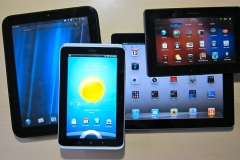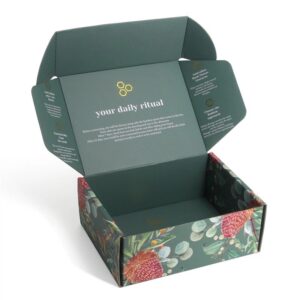 Looking back in time, there effectively were no consumer tablets in the beginning of 2010. Sure, Microsoft had Tablet PCs for nearly a decade prior, but these were heavy, had relatively short battery life and suffered from a desktop operating system that wasn’t optimized for mobile use. It was Apple’s original iPad, debuting on store shelves in April of 2010, that kicked off the current tablet frenzy. Since then, companies have jumped into this hot market, hoping to score some of the estimated 53.5 million tablet sales that research firm IDC expects this year alone.
Looking back in time, there effectively were no consumer tablets in the beginning of 2010. Sure, Microsoft had Tablet PCs for nearly a decade prior, but these were heavy, had relatively short battery life and suffered from a desktop operating system that wasn’t optimized for mobile use. It was Apple’s original iPad, debuting on store shelves in April of 2010, that kicked off the current tablet frenzy. Since then, companies have jumped into this hot market, hoping to score some of the estimated 53.5 million tablet sales that research firm IDC expects this year alone.
Tablet market recap: how did we get here?
It took time for iPad competitors to appear, however, as Research In Motion, HP, Samsung and many others scrambled to create or use new mobile operating system for such devices. At the Consumer Electronics Show this past January, a full eight months after the first iPad arrived, a slew of Google Android tablets were shown off, and I had my first hands-on experiences with RIM’s BlackBerry Playbook. And just last week, HP launched its TouchPad with the webOS system. Of course, while all this tablet activity happened in the first half of 2011, Apple improved the iPad with a successor device that’s even faster than the original, has two cameras and can stream media to HDTVs.
Fast-forward to present day, and now there are a number of tablet choices that simply didn’t exist 14 months ago. It can be overwhelming to pick and choose, because each tablet platform and device has certain pros and cons, even as most have $499 starting prices. I’m in the unique position of having at least one tablet from each platform in hand right now. After using them all in the past few weeks and months, I can’t tell you which tablet is the best for you, mainly because everyone has different needs. But my hands-on usage of these devices can offer insights as to which have standout features and which still face challenges that might not be acceptable to you.
Apple iPad: best all-arounder
 The iPad has the advantage of successful “first mover” status, so when many consumers think tablet, they think iPad. And why not? Apple prepared users for the iPad by honing the iOS operating system since 2007. Put another way: If you know how to use an iPhone or iPod touch, then you already know how to use an iPad; there’s no learning curve involved. Aside from the ease of use, the iPad has not only the most apps available to it, but it has all of what I’d call “top-tier” titles. I’d be hard-pressed to think of a killer app from another platform that doesn’t already exist for the iPad.
The iPad has the advantage of successful “first mover” status, so when many consumers think tablet, they think iPad. And why not? Apple prepared users for the iPad by honing the iOS operating system since 2007. Put another way: If you know how to use an iPhone or iPod touch, then you already know how to use an iPad; there’s no learning curve involved. Aside from the ease of use, the iPad has not only the most apps available to it, but it has all of what I’d call “top-tier” titles. I’d be hard-pressed to think of a killer app from another platform that doesn’t already exist for the iPad.
Apple’s iPad has also provided the widest array of media options for the longest time. iTunes natively has support for major music labels as well as many movie studios and TV content providers. Where it falls short in these areas. it makes up for in the apps: Netflix and Hulu Plus, for example, add content Apple has no license to provide, and these types of apps have been slow to appear on other mobile platforms. Add in simple media streaming to an AppleTV through the AirPlay function, and the iPad makes for a great media solution over competitors.
While there’s much to like. and the iPad is a known commodity with great application support, it’s not for everyone, nor for every situation. Earlier this year, I found I preferred to carry a smaller tablet outside the home and I dumped my iPad for that reason. I later picked up an iPad 2, but my use cases for it are limited to around the house: in bed, on the couch or at the kitchen table. Many consumers tote their iPad all the time,o58itf and while you can take it anywhere, it’s not as easy to use everywhere as a smaller device is. People looking for more portability might consider a 7-inch Samsung Galaxy Tab, BlackBerry Playbook, or HTC Flyer, for example.
Apple’s iOS has also had a few gaps by comparison, perhaps the most notable being the annoying notification system. That’s due to change when iOS 5 arrives in September, bringing a host of other new features that look appealing as well. If you want a large but lightweight tablet that offers a rock-solid experience and the widest array of applications, the iPad should be at the top of the list. Folks that prefer smaller tablets, need Adobe Flash support or want to customize the experience more by tinkering might consider another option.
iPad Pros: Widest selection of apps, media and accessories; solid user experience; overall stability; great performance.
iPad Cons: Lacking features desirable to some: widgets; unobtrusive notifications; variety of customization options.
BlackBerry PlayBook: Flash monster, but where’s the email?
Research In Motion took a bold step by not using their existing BlackBerry operating system for the PlayBook tablet, but it was the right call. BlackBerry OS hasn’t evolved to effectively compete against newer platforms such as iOS and Android, nor has it offered a solid web-browsing experience by comparison. Instead, the 7-inch PlayBook uses the QNX operating system, which brings many superb features, such as excellent multitasking and solid support for Flash. I also like the fast browser, excellent speakers and the gestures used to navigate the tablet’s interface as well as to wake it up from sleep mode.
 Third-party applications have been slow to appear for the PlayBook, so once you get through the basics, the software store shelves get a little bare. This is one of the two most limiting factors to the overall sales success of the PlayBook; the other is how it handles email. The PlayBook shipped without a native email client, leaving me to fend for myself with using mail in the browser. That solution works, but requires constant checking and refreshing of the browser; there’s no way for the tablet to notify me when new email arrives. If you have a compatible BlackBerry handset, however, the PlayBook can use the phone’s email client in a bridge mode.
Third-party applications have been slow to appear for the PlayBook, so once you get through the basics, the software store shelves get a little bare. This is one of the two most limiting factors to the overall sales success of the PlayBook; the other is how it handles email. The PlayBook shipped without a native email client, leaving me to fend for myself with using mail in the browser. That solution works, but requires constant checking and refreshing of the browser; there’s no way for the tablet to notify me when new email arrives. If you have a compatible BlackBerry handset, however, the PlayBook can use the phone’s email client in a bridge mode.
I personally like the 7-inch form factor of a tablet, so the PlayBook fits the bill for me in that regard. It plays Flash and other videos extremely well, and can do so while other applications are running alongside. But those videos will be limited: You won’t yet find Netflix here, for example. And that points to the software situation, which is limited. Enterprises that are BlackBerry-centric will gain more value from the PlayBook than most consumers will, although a limited number of individuals are enjoying their PlayBook purchase. They’re likely making compromises however: Not minding the necessity of pairing a handset with the tablet for email, and living without a vast array of third-party apps and media options by comparison. If you can deal with the same limitations, the BlackBerry is a portable, powerful performer and will improve when RIM releases the native email client.
PlayBook Pros: Great multitasking, Flash support, good security
PlayBook Cons: Few apps, no native email without a BlackBerry handset
HP TouchPad: a promising starter if you can wait for apps
HP’s TouchPad is the newest of the bunch, but its roots harken back to January 2009. It was then that Palm introduced its new webOS platform and the first smartphone, the Palm Pre, to run it. HP bought Palm for $1.2 billion in April 2010 and retooled the operating system not just for smartphones, but for tablets too. The HP TouchPad is very iPad-like in looks (it uses the same 9.7-inch display), packaging and components, but once powered on, it’s easy to see the different user interface approach webOS takes.
 To a large degree, the TouchPad faces the same challenge as RIM’s BlackBerry PlayBook; namely, a small number of third-party applications. So, it’s important that HP has the basics right, and in my usage, I’d say it’s mostly successful. Browsing is excellent, and the email experience is arguably second only to that of Google’s. Multitasking is effective and similar to that on the PlayBook. Other fine touches include Synergy, which bundles contact information from a number of sources and a solid Messaging system that integrates Skype video, Google Talk and other platforms into a single app. The webOS notification system may be the best of the bunch, and a unique sliding pane view of email is handy.
To a large degree, the TouchPad faces the same challenge as RIM’s BlackBerry PlayBook; namely, a small number of third-party applications. So, it’s important that HP has the basics right, and in my usage, I’d say it’s mostly successful. Browsing is excellent, and the email experience is arguably second only to that of Google’s. Multitasking is effective and similar to that on the PlayBook. Other fine touches include Synergy, which bundles contact information from a number of sources and a solid Messaging system that integrates Skype video, Google Talk and other platforms into a single app. The webOS notification system may be the best of the bunch, and a unique sliding pane view of email is handy.
HP has built a very solid tablet framework although performance isn’t yet consistent, as applications can lag at times. The company expects to address that and other open issues with a software update, even as it entices developers to build third-party applications for the TouchPad. The webOS platform shows great promise in this area: It may have the best Facebook app on any tablet, for example. I showed it off in a recent video because it has all the standard Facebook functions but also provides a unique magazine-style view of your Facebook news feed. Among all of the new tablet contenders to the iPad’s reign, I think the TouchPad shows the most promise for these reasons. If you’re willing to take a chance and wait for HP and developers to tune the TouchPad and supporting apps, HP’s new tablet is well worth the look.
TouchPad Pros: Possibly the best multitasking and notifications. Basics are well done. Wireless charging.
TouchPad Cons: Very new, so a work in progress. Few apps, media choices.
Google Android tablets: too much choice isn’t always good
 There isn’t just one Android tablet, which is both good and bad. By allowing hardware manufacturers to use Android how they see fit, consumers have a wide range of tablet choices with sizes ranging from 7 inches to 10.1 inches. Some Android tablets have 3-D cameras, while others don’t; the same can be said of USB ports, memory card slots, and full keyboard docks. But Android tablets from Motorola, Samsung, LG, Acer, Asus and others share one commonality: They all run on Google’s Honeycomb operating system.
There isn’t just one Android tablet, which is both good and bad. By allowing hardware manufacturers to use Android how they see fit, consumers have a wide range of tablet choices with sizes ranging from 7 inches to 10.1 inches. Some Android tablets have 3-D cameras, while others don’t; the same can be said of USB ports, memory card slots, and full keyboard docks. But Android tablets from Motorola, Samsung, LG, Acer, Asus and others share one commonality: They all run on Google’s Honeycomb operating system.
Although Honeycomb was the first tablet platform to follow Apple’s iPad, it actually appears to need the most work yet. No matter which Honeycomb tablet I use, I still see stability issues in the form of software crashes or applications that don’t properly scale up. Stability is less of an issue with Android 3.1, but the third-party application situation hasn’t noticeably improved in a meaningful way. For some reason, software developers aren’t rushing to build or port apps for Google tablets. Simply put: Honeycomb felt rushed to me when I first used it in February, and it hasn’t fully matured yet.
It’s not all bad, however. Users of Gmail, Google Talk video calling and Google Maps will find much to like. These services run well on Android tablets — better than on other platforms, where they’re available. This is part of the reason I switched to a Google Android smartphone last year. Google Music shows promise, as does Google Video for movie rentals and purchases. And although not as flashy as competitors, Android’s multitasking is effective.
 But more than any other tablets available today, those running Honeycomb appear most like a poor imitation of Apple’s iPad. It’s as if Google is trying to enable all the same features and functions, but falling short in the user experience: a common complaint of Android in general, although I believe the platform has greatly improved over time. I actually prefer the Gingerbread experience — created for smartphones — on my small Galaxy Tab over any of the Honeycomb tablets I’ve used, and I’ve used a few, ranging from the Motorola Xoom to the budget-friendly Acer Iconia Tag A500, plus some in-between.
But more than any other tablets available today, those running Honeycomb appear most like a poor imitation of Apple’s iPad. It’s as if Google is trying to enable all the same features and functions, but falling short in the user experience: a common complaint of Android in general, although I believe the platform has greatly improved over time. I actually prefer the Gingerbread experience — created for smartphones — on my small Galaxy Tab over any of the Honeycomb tablets I’ve used, and I’ve used a few, ranging from the Motorola Xoom to the budget-friendly Acer Iconia Tag A500, plus some in-between.
Early adopters of Android smartphones have seen this before with the platform, and may be apt to ride out the situation as Android tablets improve. But other consumers may be hard-pressed to deal with Android’s current nuances, issues and lack of software. If you like the ability to hack around in Android and don’t mind software crashes, or if you’re a heavy user of Google services and are willing to wait for platform improvements, you have a number of Android tablets to choose from.
Android Pros: Excellent Google service integration; wide range of hardware options and tablet sizes.
Android Cons: Stability isn’t perfect; app selection is lacking; limited but growing number of media services.
The best tablet is the one that meets your needs
As a secondary device, it’s likely most people don’t even need a tablet. Smartphones, netbooks and notebooks can easily suffice for mobile computing needs. But tablets have their strengths too, offering a personal, more immersive touchscreen experience in many situations. Those situations vary, as do all our individual preferences and requirements for a tablet device. That’s why there’s no “best” tablet I can recommend for everyone. Each has something unique to offer, while all of them are likely to improve over time.
Most are made with similar — if not the same — hardware components too, so that places a greater emphasis on the user experience, software and ecosystem. For many consumers, Apple’s iPad brings the total package like no other tablet, as evidenced by sales figures. But the young tablet market offers something for everyone, and that means you can pick and choose which suits you best; something you couldn’t do before this year.
See also:
Top 10 ways iPhone 5 can see off Samsung Galaxy S2
Top 6 Useful Web Apps To Help You Job Hunt
Top 5 Attractive Widgets To Personalize Your Android Phone
Top 10 Must Have iPad 2 Apps For New And Existing Users
Top 20 iPhone Productivity Apps for Organized and Lazy
Top 10 Battery Usage Tips, Hacks and Tricks
Top 120 SEO Resources for Bloggers



Cool, Yes,i also really like to visit new place,your idea is good.